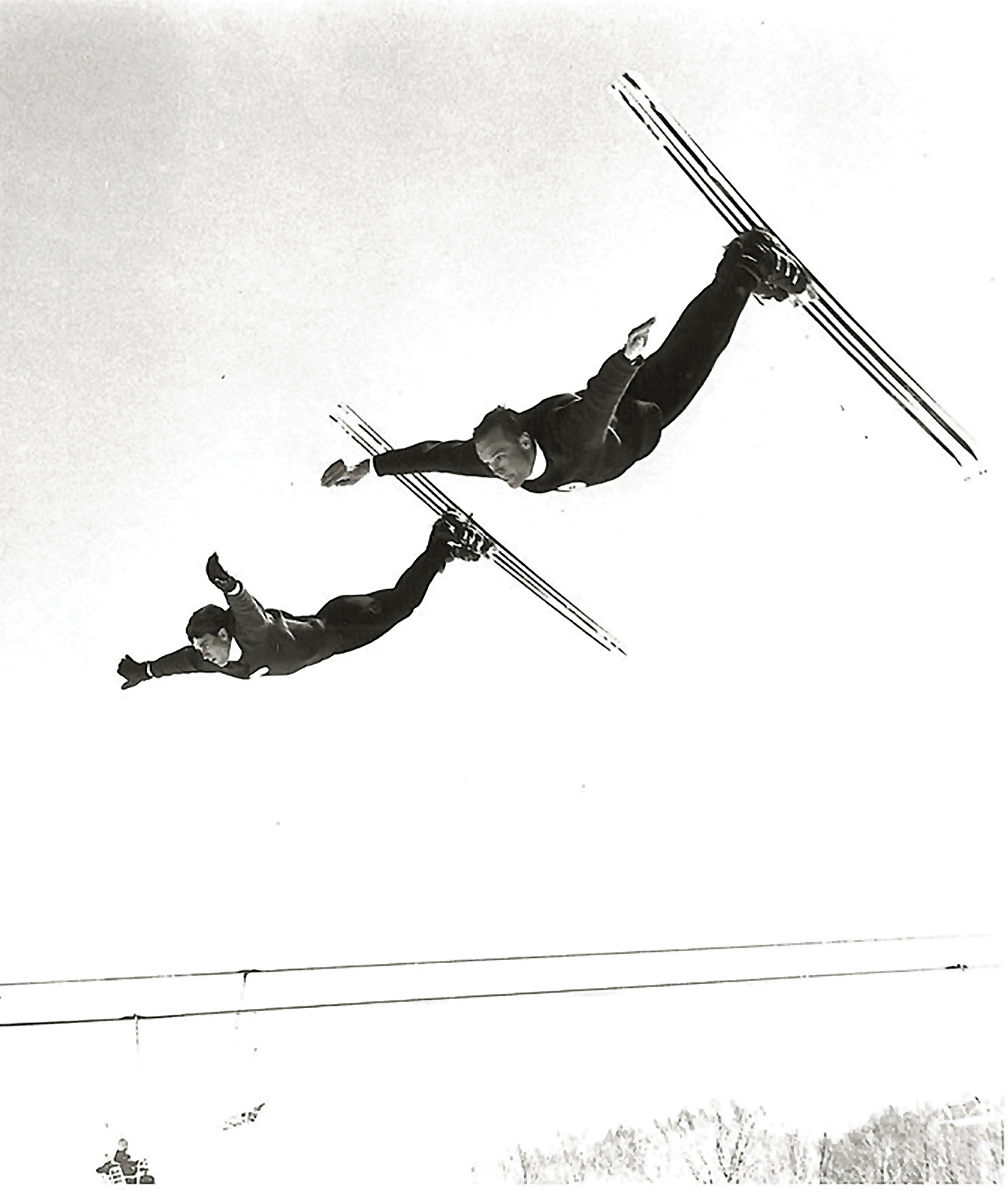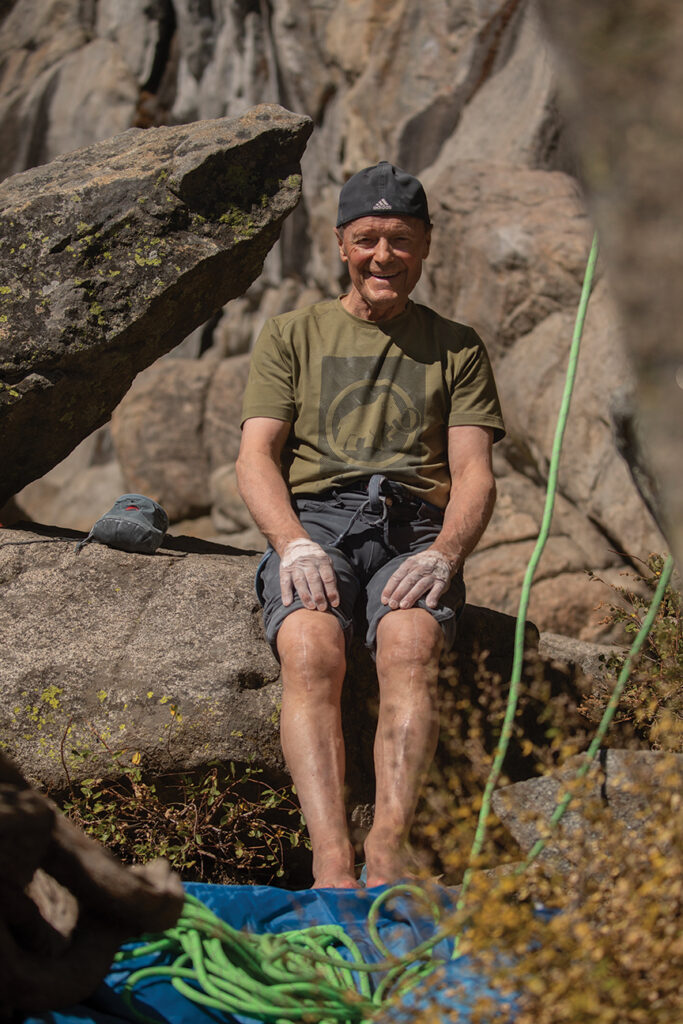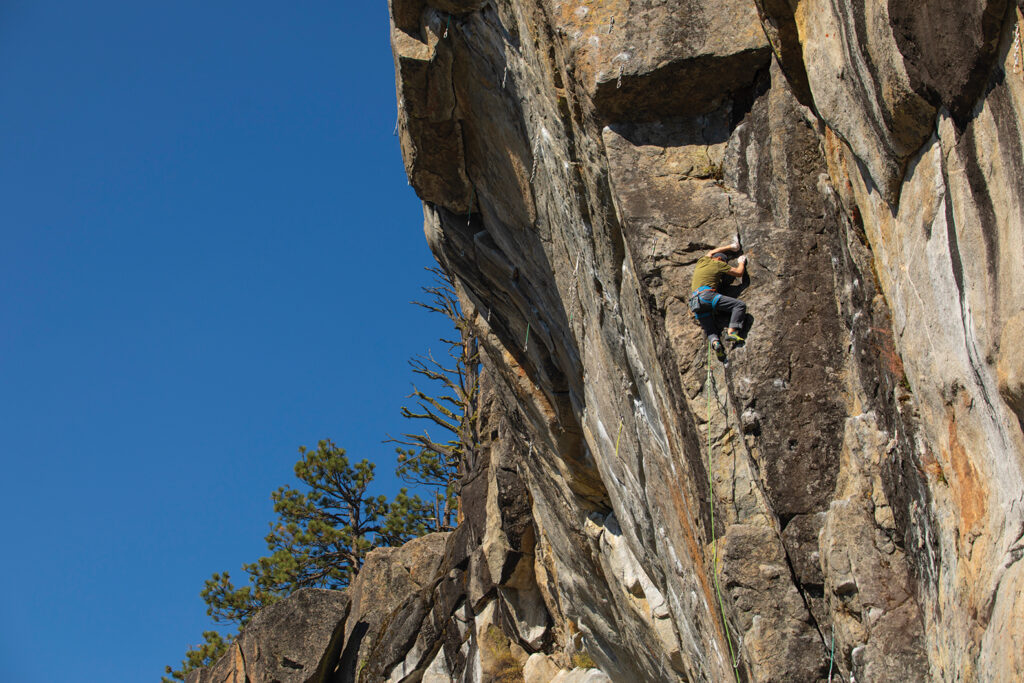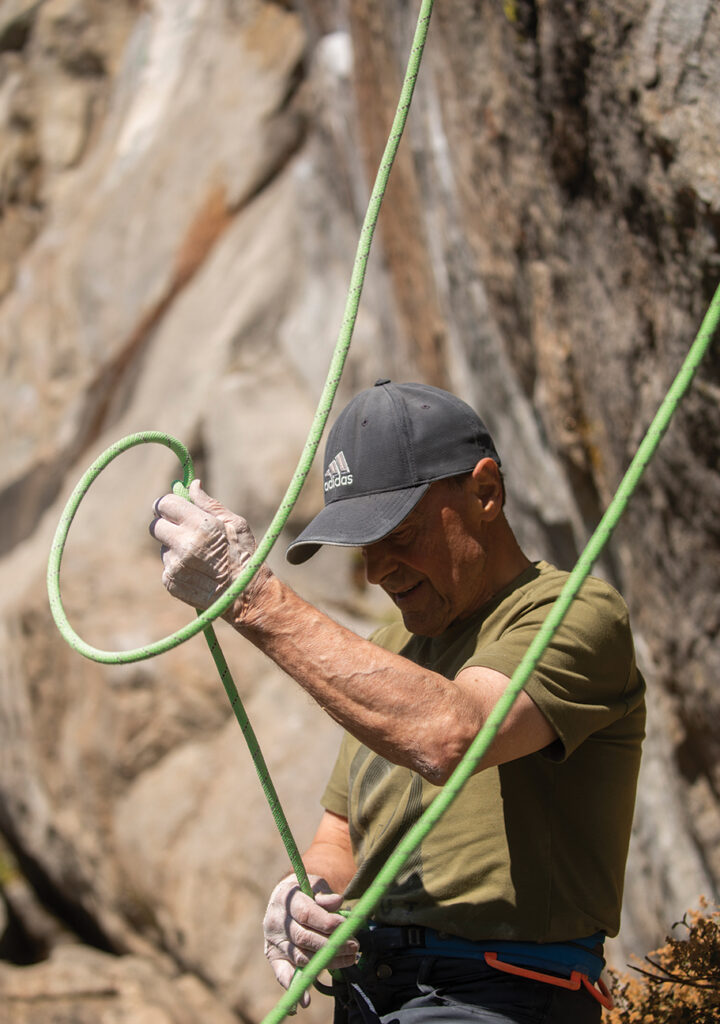
27 Sep Hermann Goellner: Reflecting on the Career of a Freestyle Skiing Pioneer

Hermann Goellner shows off the scars from his two knee replacement surgeries, photo by Ryan Salm
Still fit and climbing rocks at age 78, Goellner in his prime was among a rare breed of innovative freestyle skiers, performing fearless inverted tricks well before they became the norm
In the taproom of the Reno Whole Foods, Hermann Goellner, an Austrian-born pioneer of freestyle skiing who has lived in the Tahoe area for nearly 20 years, demonstrates how to make a Möbius strip.
If you’re not familiar with the concept, then it helps to have a little background. August Ferdinand Möbius was a German mathematician in the 1800s. Much of his legacy hinges on the discovery of the Möbius strip: “a non-orientable two-dimensional surface with only one side when embedded in three-dimensional Euclidean space.”
If the technical definition doesn’t do much to improve your understanding, you’re not alone.
The Möbius strip is what is sometimes referred to as an “impossible shape.” Impossible in the sense that it doesn’t appear in the natural world. It can, however, be created by people.
Goellner is kind enough to demonstrate this. He picks up a napkin and starts to fold it widthwise, once, and then again and again, until he is left holding a single strip of material.
“If you take a strip and put the two ends together,” he explains, “the inside will always be the same and the outside will always go back into the outside. If you take that strip apart and you give it one full twist and you bring those two sides together again, then the outside will become the inside and the inside will become the outside.”
Goellner twists the strip so that it looks like a crinkled, brown corkscrew. Then he brings the edges back together so that he’s left holding a kind of warped circle.
“That’s called the Möbius strip,” he says. “You can look it up on the Internet.”
Take his advice. Sometimes we need to see a thing to better understand it, and, if not that, then at least understand that a thing’s impossibility doesn’t preclude it from being real.
This is particularly true in the case of Hermann Goellner, a man who is neither a mathematician nor a scholar of mathematics, but who has, all the same, spent a great deal of his life conjuring up impossible shapes before attempting to export them into the real world.
Unlike August Ferdinand Möbius, whose work in mathematics revolved around the study of how lines and curves orient themselves in three-dimensional space, Goellner was focused on understanding his own body’s relationship to physical boundaries.
In fact, for the man who invented the daring “Moebius Flip,” it’s fair to say that his life depended on it.
Well-Rounded Athlete
Goellner’s sharp wit and sturdy physique belie his age. But some half century after the prime of his career, which he spent stomping enormous inverted airs to his feet, he feels every bit of his 78 years.
“This is my first year in 76 years that I didn’t ski,” says Goellner. “I have two artificial knees and when the skiing gets a little rough, they hurt.”
Now, Goellner spends most of his time climbing, sometimes down in Bishop or Red Rocks near Las Vegas, but mostly in the High Sierra and on Donner Summit, a short drive from his Verdi home.
Climbing isn’t exactly a new hobby. Goellner has been mountaineering in one form or another since he was a kid in the Alps.
“When you grow up in a mountain village, there are two things you do: You climb and you ski,” says Goellner, a world-class athlete in both sports during his heyday—and still a capable climber despite his declining grip strength.
“I think that Hermann is, if not the best, then he is certainly among the best sport rock climbers of his age,” says Dick Dorworth, a fellow hall of fame skier, climber and friend of Goellner’s since the 1960s.
But while climbing remains a passion of Goellner’s—it was one of the reasons he accepted the head ski coach position at the Sugar Bowl Academy in 1999, after all—it was his incredible skiing feats that put him in the history books.
Goellner’s skiing prowess can be traced back to his upbringing in the Austrian resort town of Zell Am See, where he excelled throughout his youth in soccer, gymnastics and alpine ski racing.
In 1959, Goellner claimed the Austrian Junior Championship GS title at age 16. He then broke both of his legs in a horrific downhill training crash the next season. After returning to the snow to win the European Junior Championship combined in 1961, Goellner wrecked a new Audi that he had purchased on credit while driving back from a climbing trip in the Dolomites.
Given the hefty debt he owed, he decided to immigrate to the United States—a move that reportedly led legendary alpine ski racer Jean-Claude Killy to wonder what Goellner could have accomplished for his Austrian team had he stayed.
Nevertheless, Goellner went on to become a successful ski racing coach for decades (and even invented the screw-in, breakaway slalom gate that is still used today). Yet it was during a relatively brief period in his life when he strayed from his racing roots that Goellner earned his status as a true pioneer of the sport.
The Genesis of an Inverted Stunt
The first time Goellner decided to turn his world upside down, he was 21 years old.
He was training on a glacier with the Austrian alpine ski team in the late fall of 1964 when one of their coaches devised a scheme: Each student would ski downhill, launch themselves off a ramp and see if they could land properly.
The exercise was challenging, to say the least. Goellner and his teammates either leaned too far forward or tilted back and landed on the tails of their skis. Thankfully, there was 4 feet of powder snow to cushion their falls. The coach even seemed to get a kick out of watching them struggle.
“He was standing on the side and every time we crash-landed, we heard him hollering laughing,” Goellner says.
It was precisely this combination of factors—both the certainty of a soft landing and his coach’s schadenfreude—that got Goellner devising a scheme of his own.
“If I already land by leaning back a little bit, why don’t I bring the skis up over my head and do a somersault?” he recalls.
Goellner had never done one before, especially not on skis that were over 2 meters long, but he had a strong gymnastics background. His body contained the type of muscle memory he needed to complete a single flip. He was already familiar with the required motion, and if he messed up, he had soft powder to break his fall.
So, he went for it. He launched himself into the air, brought his skis over his head, and landed perfectly.
His coach was not pleased. In fact, the idea that Goellner had taken what was supposed to be a rigorous training exercise and transformed it into something fun downright pissed him off.
But Goellner hadn’t attempted the flip on a whim. He’d made a number of small but important calculations in his head: about the snow, his safety, his ability and, of course, the pleasure he might derive from one-upping his coach.
What Goellner may not have predicted is just how much he would love flipping through the air, or how much that single flip would alter the trajectory of his skiing career.
Later that winter when he moved to Killington, Vermont, to work as a ski instructor—while also competing on the professional ski racing circuit—he brought his enthusiasm for aerial acrobatics with him.
“When I came to the States, I thought I was the only guy doing somersaults in the world,” he says.
Goellner was certain that he was going to become famous.
He was both right and wrong. He was going to be famous, at least eventually. He just wasn’t the first person in the world to perform a somersault.
Pioneers of Freestyle
In reality, people had been doing flips on skis since the beginning of the twentieth century. There was John Rudd in 1906. National Geographic’s February 1920 issue featured a photo of Johnny Carleton doing a front flip in the hills of New Hampshire. In the 1930s, Bill Robes reportedly performed somersaults for $50 a pop at Dartmouth’s winter carnival to help pay for tuition.
Stein Eriksen, however, was the first person to do a somersault with the kind of pageantry and artistry that was capable of transforming the act itself—that of a single body completing one rotation through the air—into a much larger movement known as freestyle skiing.
What made Eriksen’s somersault different from those of his predecessors had to do with his method of takeoff. The Norwegian skier constructed a ramp to shoot himself high into the air. Once airborne, he relied on his gymnastics background to complete a layout front pike. This slight modification—his body long and straight, his arms stretched out wide above his head—added an air of confident refinement to the stunt.
Eriksen first performed this kind of somersault for American audiences in Sun Valley, Idaho, in the winter of 1953. He continued to wow people with his aerial routine as he moved to different resorts across the country. He traveled from northern Michigan to Tahoe’s Heavenly Valley, and eventually, to Vermont’s Sugarbush Resort, just an hour north from Killington, where Goellner had started performing his own weekly somersault demonstrations.
When Goellner found out about Eriksen, he was bummed out. His love of somersaults was tied not only to the act of doing them, but to the knowledge that he was somehow changing the sport, opening some unseen door that made the whole enterprise feel a little bigger.
Apart from time travel, there was nothing Goellner could do to change the fact that skiers had been somersaulting through the air, in one form or another, for half a century. But he didn’t despair. Goellner still wanted to do something. Something new. Something different. The kind of thing that, even if people had conceived of it in their heads before, no one had been able to pull off yet.
So he decided to up the ante.
He started training with a fellow Killington instructor, Tom Leroy, who had his own background in the high dive. Together, they practiced aerial inversions until they were both landing double somersaults at their weekly ski demonstrations in the winter of 1966.
“We did that on the local level and then, pretty soon, the news went out,” Goellner says. “The newspapers and the journals got a hold of it. The ski magazines got a hold of it. And then Hart Ski got together with Summit Films and they brought us out to Vail as part of their film team.”
The first movie Goellner appeared in, Ski the Outer Limits, was produced by Barry Corbet and Roger Brown of Summit Films. Over the course of 30 psychedelic minutes, the movie showcases some of the most daring aerial stunts the sport of skiing had to offer, including the signature double backflips of Goellner and Leroy. The film also shows the two performing flips into Corbet’s Couloir at Jackson Hole—in an era when few skiers were bold enough to even drop into the notoriously precarious couloir, much less launch an inverted air.
Though they were training partners, Goellner and Leroy were also competitors. After his big movie debut, Goellner wanted to raise the stakes, so he traveled back to Austria to train. Not on the slopes, but in the gymnasium.
“I said, OK, if I do a somersault with a twist, that will pretty much shut Tom down, not because he couldn’t do it, but because he didn’t want to spend six months in the summer training for it,” says Goellner.
It might sound simple enough—a somersault with a twist—but that slight, additional rotation of Goellner’s body would be enough to turn the world of skiing on its head.
‘A Phantasmagorical, Optical Delight’
It goes without saying: The first time a skier performs an aerial trick for an audience is not the first time the skier performs the trick itself. The same is true of Goellner and his somersault with a twist.
“In gymnastics, at that time, it was a pretty well-known stunt,” he says.
He first spent time in the gymnasium, swinging from the high bar, getting familiar with the type of rotation he had already envisioned in his head. Once he felt comfortable with his performance in the gym, he decided to transition to the snow. He also embraced more aggressive hand movements to generate the kind of momentum he would need to complete the trick. It was only when he was able to consistently land the backward somersault with a full twist that he got in touch with Corbet and Brown.
They had just one question: “How can we make a film about that?”
Their answer was to give Goellner’s trick not only its own name, but an entire backstory that riffed, at least loosely, on the work of German mathematician August Ferdinand Möbius.
They christened both the trick and the film The Moebius Flip.
At the time of its release in 1969, Skiing editor Doug Pfeiffer called The Moebius Flip “a phantasmagorical, optical delight, the likes of which you’ll find in the turned-on final scenes of Stanley Kubrick’s 2001.”
It’s hard to improve upon Pfeiffer’s original review, if only because he does a good job of capturing the spirit of the film. It’s bold. It’s bright. It is, to quote the slang of the time, “far out.” It’s also worth noting that the film does have a plot.
The movie opens on a group of young skiers enjoying a day out in Vail. They’re carving, spinning and frolicking their way down the slopes without a care in the world. The sun is shining. The vibes are good. When they’re not skiing, they’re either juggling, dancing or so overcome by laughter and delight that they find themselves sprawled out in the snow.
But then, a breaking news report interrupts their day.
“We interrupt this program to make an important announcement,” a newscaster says. “Observatories everywhere in the world are reporting an unexplained reversal of polarity in subatomic particles throughout the universe. The effects this emergency will have on life are not yet known, although scientists agree that perception will be dramatically altered, perhaps even reversed.”
At this point in the film, everything goes topsy turvy. Colors are inverted. The skiers, unable to maintain their balance, go tumbling down the slopes. Up becomes down and down becomes up.
“Since the nature of the universe has been compared to that of a Möbius strip,” the newscaster continues, “that is, also with a twist in it, scientists feel that the Möbius strip is the key to emerging on the right side of perception.”
It’s only when Goellner is able to successfully perform the Moebius Flip that the world returns to the way it once was.
If the movie doesn’t seem to make a lot of logical sense, that’s OK. It doesn’t have to. More important than the science that shapes the world within the film is how the film itself ends up shaping the world around it.
“Once it got into the ski films, it exploded nationwide,” says Goellner.
“It” being both the willingness and the desire among skiers to launch themselves into the air and make their own impossible shapes.
By the winter of 1971, just two years after the release of The Moebius Flip, the first professional freestyle skiing competition took place in Waterville, New Hampshire.
Goellner competed. In fact, he won by performing a single backward somersault.
“When freestyle came in,” says Dorworth, a Tahoe native and ski historian, “he was so far ahead of the curve that he was spectacular.”
Too Far Ahead of the Curve
It seemed, at least at the time, that freestyle skiing, and Goellner, were about to take the world by storm.
And that was true, at least until it wasn’t.
The same movies that popularized freestyle aerial skiing also resulted in a number of serious injuries, particularly in kids and untrained athletes.
In the winter of 1973, while competing at the Rocky Mountain Freestyle Contest, skier Scott Magrino was permanently paralyzed from the waist down after landing on his head during an attempted double backflip. The same thing happened that winter to Peter Herschorn, reportedly the fourth-ranked freestyle aerialist in the world at the time.
In response, ski areas and resorts across the country started banning inverted aerials. Prominent ski magazines even stopped running photos of inverted tricks, a choice that was meant to deter both youngsters and amateurs from taking big risks.
“When that happened I realized, well, in this business, there is no future, so I put all my emphasis into becoming a ski racing coach,” says Goellner.
By the time aerial inversions were allowed in competition again, a decade had passed. Goellner had spent that time climbing the ladder as a ski coach, graduating from an instructor at one resort to the founder of his own ski racing program at Stratton Mountain in Vermont, and eventually, the head coach of the U.S. Women’s 1980 Olympics Team.
All the while, the sport of freestyle skiing continued to evolve. Goellner had been the first skier to land a triple front flip in 1969. Ten years later, skiers were regularly performing double somersaults with triple twists and double twisting back doubles.
Goellner felt outdated. What he could do was no longer in demand.
For a time, he thought he could return to freestyle aerials, maybe even learn how to complete the newest and biggest tricks, particularly given the vast improvements in training facilities and methods, but a simple truth remained.
“At that point, I was getting too old for that sport,” he says.
A Showman’s Perspective
Back at the Reno Whole Foods, Goellner brings up the subject of a Canadian man who once attempted a double front flip on his motorcycle. Though the name escapes him, it is easy enough to figure out the man’s identity with a quick Internet search: Bruce Cook.
Cook is neither a skier nor a climber. He’s a freestyle motocross rider whose fame is largely tied to attempting the sport’s first double front flip in 2014. Unfortunately, he over-rotated, crashed and broke his back, leaving him paralyzed from the waist down.
On its face, Cook’s story is a tragic one, though Goellner sees things a little differently.
“You have to admire that part of the human condition,” he says, “that adventurism, that desire to push the boundaries, to discover new territory.”
What fascinates Goellner about Cook is not the injury or the stunt itself, but the fact that someone was willing to try something new and dangerous for the sheer sake of seeing if he could do it.
“What do you call that? Do you call that stupid?” he asks.
The question is largely rhetorical. Goellner is asking it of Cook just as much as he is asking it of himself—or, at least, of his former self.
The way he sees it, Cook’s accident comes down to what he calls “one tiny kernel of miscalculation.”
Just as he did with the napkin and the Möbius strip, he demonstrates what he means by cocking his hands and arms at various angles, as if one were Cook and the other were his takeoff ramp. He hypothesizes about what would have happened had the bike touched down a second earlier or had his body been situated just a little differently. This, too, is indicative of Goellner’s fascination with the impossible. What happened can’t be changed. Even so, Goellner picks apart the details. He speaks about the miscalculation as if it were his own, or rather, as if it could have been.
And it is in this moment that it becomes apparent that he’s not really talking about Cook anymore.
“In my time, going for the triple, it was every bit as dangerous as the guy on the motorcycle going for the double,” he explains.
Goellner recounts the slim, nearly nonexistent margin of error for performing some of his biggest tricks. His back arches in his seat or his head shifts to the side as he imagines just how things could have gone wrong.
Even someone who has never done anything remotely resembling a flip on skis—single, double or otherwise—can relate to what Goellner is feeling. Like life itself, the very fact that our vulnerable bodies continue to exist in the world is at the same time remarkable and impossible.
It can be hard to square the singular truth of being alive with the awareness that, had a seemingly infinite number of variables been even slightly different, we might not be.
This feels particularly relevant in Goellner’s case because he really did spend a significant part of his life performing tricks that could best be described as death-defying.
Now, apart from climbing, Goellner spends most of his time down here on the ground.
As he sits across the table, however, it is easy to imagine that part of him is somewhere else, perhaps high above the snowy slopes of a distant memory.
Matt Jones is a Reno-based writer with a newfound respect for skiing’s freestyle pioneers.
Hermann Goellner Career Highlights
• 1959: Winner, Austrian Junior Alpine Championships GS
• 1961: Winner, European Junior Alpine Championships combined
• 1964: Immigrated to the United States and settled in Killington, Vermont
• 1965: Performed first double backward somersault
• 1967: Performed first forward triple somersault
• 1968: Created the Moebius Flip
• 1971: Winner of first premier international freestyle competition at
Waterville Valley, New Hampshire
• 1971–1985: Served as head coach at Stratton Mountain School with
two-year break to lead women’s U.S. Ski Team
• 1987: FIS adopts Gollner’s screw-in slalom pole
• 1986–2013: Held head coaching positions at Aspen, Squaw Valley
and Sugar Bowl

Hermann Goellner, a nearly lifelong climber who grew up in the Alps, scales a granite wall on Donner Summit, photo by Ryan Salm

Goellner prepares his gear during a recent climbing outing on Donner Summit, photo by Ryan Salm




Eric West
Posted at 15:54h, 25 AugustI realize this story is several years old, but if there is any way you can reach Herman and tell him hi from Gordon West (my dad). He and Hermann coached together for a couple of summers in the early 1970’s at Timberline in Oregon. I remember the acrobatics Hermann would perform on the trampoline they set up inside the lodge.